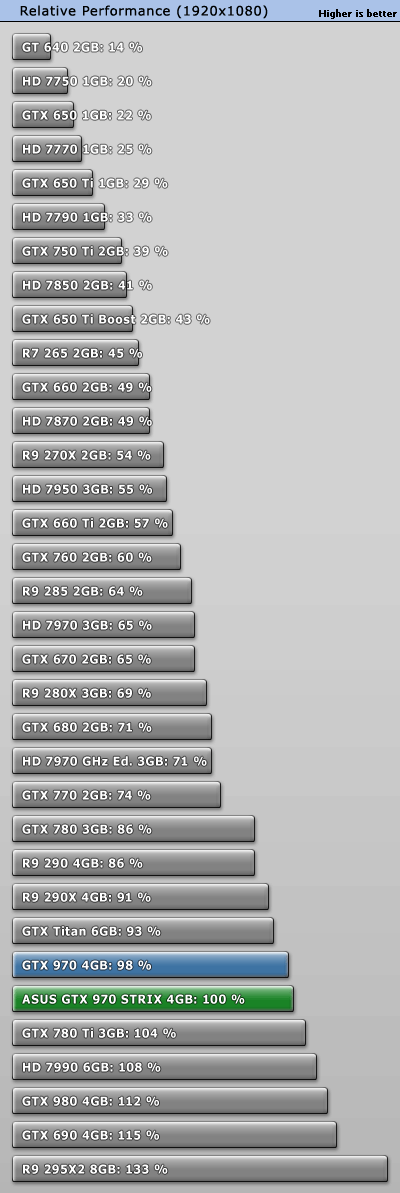Dubyah Bush :
q
Oh no, I understand, but if your choice is between a 290x and a 970 I pick the 290x. If it were a 980 and 290x I would say get the 980. I predict the 970 is going to end up being a piece of garbage when people try to SLI them as we move into higher resolution gaming unless Nvidia can fix their vram issue somehow.
Why worry about predictions when the data is there to be read. Here's the performance of the 970 in SLI at 2560 x 1600 .... completely free of the dire predictions you describe
http://www.techpowerup.com/reviews/NVIDIA/GeForce_GTX_970_SLI/20.html
Tomb Raider goes from 29.8 to 58.7; scaling = 96.98%
Battlefield 3 goes from 62.1 to 121.4; scaling = 95.49%
Far Cry 3 goes from 35.6 to 68.8; scaling = 93.26%
Crysis 3 goes from 22.5 to 43.3; scaling = 92.44%
Thief goes from 70.8 to 136.1; scaling = 92.23%
Bioshock Infinite goes from 76.7 to 143.9; scaling = 87.61%
Splinter Cell: Blacklist goes from 49.5 to 92.2; scaling = 86.26%
Battlefield 4 goes from 45.0 to 83.2; scaling =84.89%
Metro LL goes from 40.7 to 74.6; scaling = 83.29%
Batman: Arkham Origins goes from 81.8 to 148.3; scaling = 81.30%
And if you're gonna come back with 4k.... until there's a pair of cards that can do 60 fps across the board in TPUs test suite, 4k isn't on my radar. As you'll see below, it currently affects only on 0.06% of the gaming market and I din't see it being a factor untilo 2016 or later. But even at 4k, scaling in demanding games is ... well the numbers speak for themselves.
Crysis 3 96.43%
Battlefield 3 94.85%
Splinter Cell BL 94.05%
BioShock Infinite 93.59%
Tomb Raider 93.41%
Batman: Origins 93.27%
Thief 93.26%
Far Cry 3 91.96%
Assassins Creed 4 90.07%
Battlefield 4 88.57%
Watch Dogs 79.58%
Metro LL 71.86%
Joe Newbie :
I think 90% of gamers game on 1080p, presently. If you think Nvidia isn't going to have a new GPU targeted to the 970 price point in 2-3 years when prices on higher res monitors make them more available to the vast majority of gamers, simply put, you're mistaken. The limitation on high res gaming is less about the GPU and more about the prohibitive costs of the monitors themselves. 2 to 3 years that will sort itself out, and by then Nvidia and AMD will have new products able to drive those higher res monitors better and for lower prices than dual 970's would today.
No need to guess..... go here and see who's hitting steam servers (not office workers):
http://store.steampowered.com/hwsurvey
Scroll down a bit and hit (Under Feb 2015) "Primary Display Resolution"
1366 x 768 = 26.43%
1920 x 1080 = 34.02%
2560 x 1440 = 1.03%
3840 x 2160 = 0.05%
5760 x 1080 = 0.06%
You can also look at what GFX cards are being used
GTX 970 = 1.80 %
All R7 + R9 cards combined = 1.62 %
That represents cards hitting steam servers in the month of February which represents 5 months of sales on the 970 and up to 16 months of sales on the R9 / R7 series.


 we have CPU for cpu power, and GPU for gpu power. why would you want to buy expensive gpu to run it 50% gpu and 50% cpu and that will be slower than an oldder cpu anyway... just upgrade to i5 4690k and gtx 970. you will be happy for years
we have CPU for cpu power, and GPU for gpu power. why would you want to buy expensive gpu to run it 50% gpu and 50% cpu and that will be slower than an oldder cpu anyway... just upgrade to i5 4690k and gtx 970. you will be happy for years
